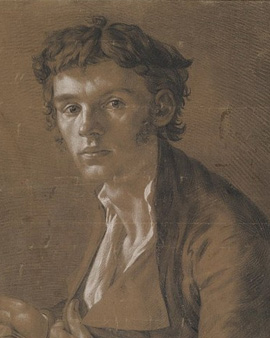


When one hears about Philipp Otto Runge that some of the works of art that Johann Wolfgang von Goethe acquired from him were judged with the quote "to become furious, great and beautiful at the same time", then that is already a remarkable distinction. Philipp Otto Runge is one of the most important painters of the North German early Romantic period. A number of other great artists and writers also belonged to this epoch, such as Caspar David Friedrich, Friedrich Gottlieb Klopstock, Carl Spitzweg, in England William Turner and in France Eugene Delacroix.
In their works, Romantics have tried to put the human mind in the foreground and make it one with the infinite. Thus the term 'romantic' stands for the emotional, as opposed to the intellectual. This state of mind gave priority to feeling over reason and sought the secret of life in the domestic world of fairy tales and legends. Around 1840 the time of the romanticists ended. Runge's life was certainly not easy. He was born in 1777 and was the ninth of eleven siblings. His parents were merchants in the Pomeranian sea and trading town of Wolgast. Philipp Otto Runge fell ill with tuberculosis in his youth at the age of 12. He moved to Hamburg with his eldest brother in 1795 to start an apprenticeship as a merchant. Through friends of his brother he met people who recognized his artistic inclinations and abilities, such as the poet and dramatist Friedrich Gottlieb Klopstock. They recommended that Runge start drawing and study ancient authors. Philipp Otto Runge came into contact with painting quite quickly through other friends.
He painted wide landscapes with people floating in them, angels and allegorical beings, romantic and transfigured at the same time. His portraits of his family, his children and self-portraits also always show romantic and tenderly sensitive strokes. Runge was inspired by the idea that landscape should reflect an almost religious and mystical mood. He therefore named his subjects with the attribute 'Landschaftery'. He was both a seeker and a sensitive performer. Runge's vision was to combine painting, poetry, music and architecture into a total work of art. In this he was far ahead of his time.
At the same time Runge made silhouettes of people and plants. His plant cuttings are probably also the ones that so appealed to Goethe in their beauty. Runge sees in these miniature works the romantic piety of nature, the "living spirit of God", which is visible in detail. Philipp Otto Runge is also the author of the stories "Von dem Fischer un syner Fru" and "Von dem Machandelboom". His life's work includes the recording of these stories, which were previously only passed on orally and are still valued today. The Brothers Grimm incorporated them into their collection of children's and household tales. Runge died far too early at the age of 33 in 1810.

When one hears about Philipp Otto Runge that some of the works of art that Johann Wolfgang von Goethe acquired from him were judged with the quote "to become furious, great and beautiful at the same time", then that is already a remarkable distinction. Philipp Otto Runge is one of the most important painters of the North German early Romantic period. A number of other great artists and writers also belonged to this epoch, such as Caspar David Friedrich, Friedrich Gottlieb Klopstock, Carl Spitzweg, in England William Turner and in France Eugene Delacroix.
In their works, Romantics have tried to put the human mind in the foreground and make it one with the infinite. Thus the term 'romantic' stands for the emotional, as opposed to the intellectual. This state of mind gave priority to feeling over reason and sought the secret of life in the domestic world of fairy tales and legends. Around 1840 the time of the romanticists ended. Runge's life was certainly not easy. He was born in 1777 and was the ninth of eleven siblings. His parents were merchants in the Pomeranian sea and trading town of Wolgast. Philipp Otto Runge fell ill with tuberculosis in his youth at the age of 12. He moved to Hamburg with his eldest brother in 1795 to start an apprenticeship as a merchant. Through friends of his brother he met people who recognized his artistic inclinations and abilities, such as the poet and dramatist Friedrich Gottlieb Klopstock. They recommended that Runge start drawing and study ancient authors. Philipp Otto Runge came into contact with painting quite quickly through other friends.
He painted wide landscapes with people floating in them, angels and allegorical beings, romantic and transfigured at the same time. His portraits of his family, his children and self-portraits also always show romantic and tenderly sensitive strokes. Runge was inspired by the idea that landscape should reflect an almost religious and mystical mood. He therefore named his subjects with the attribute 'Landschaftery'. He was both a seeker and a sensitive performer. Runge's vision was to combine painting, poetry, music and architecture into a total work of art. In this he was far ahead of his time.
At the same time Runge made silhouettes of people and plants. His plant cuttings are probably also the ones that so appealed to Goethe in their beauty. Runge sees in these miniature works the romantic piety of nature, the "living spirit of God", which is visible in detail. Philipp Otto Runge is also the author of the stories "Von dem Fischer un syner Fru" and "Von dem Machandelboom". His life's work includes the recording of these stories, which were previously only passed on orally and are still valued today. The Brothers Grimm incorporated them into their collection of children's and household tales. Runge died far too early at the age of 33 in 1810.
Page 1 / 2






